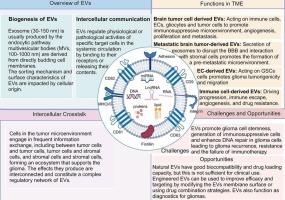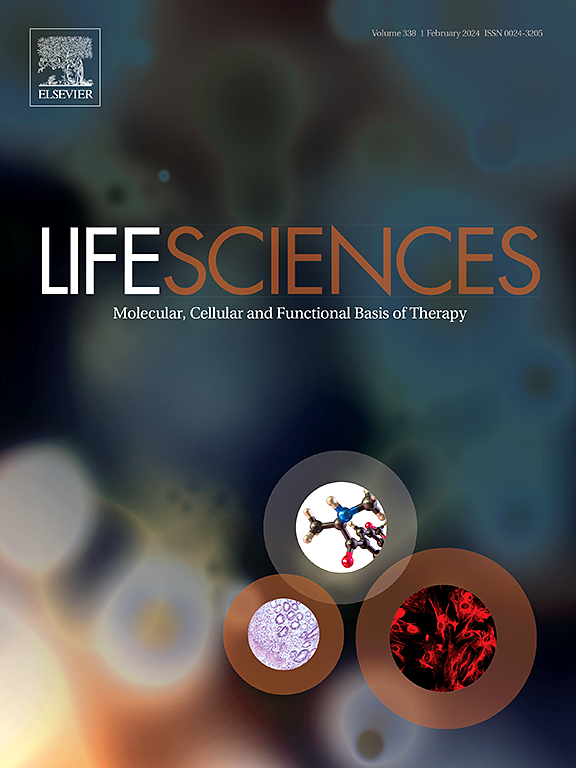细胞外小泡在胶质瘤中的作用:挑战还是机遇?
IF 5.2
2区 医学
Q1 MEDICINE, RESEARCH & EXPERIMENTAL
引用次数: 0
摘要
胶质瘤正日益成为影响人类健康的主要疾病,而目前的治疗方法并不像预期的那样有效。深入了解胶质瘤的异质性以及寻找新的诊断和治疗策略似乎已迫在眉睫。胶质瘤会适应周围环境并形成一个支持性肿瘤微环境(TME)。胶质瘤细胞会通过携带核酸、蛋白质和脂质等生物活性物质的胞外囊泡(EVs)与周围细胞进行交流,这与各种代谢途径的改变和生物行为的调节有关,这种调节可以是双向的,广泛存在于 TME 中的细胞之间,构成了一个复杂的相互作用网络。这种复杂的调控会影响胶质瘤的治疗,导致不同类型的抗药性。由于在各种体液中分离 EVs 的可行性,它们在胶质瘤的诊断和监测中有着广阔的应用前景。同时,EVs 穿过血脑屏障(BBB)的特性也赋予了它们作为药物输送系统的潜力。在这篇综述中,我们将重点讨论不同细胞来源的EVs在胶质瘤微环境和细胞间调控网络中的作用和功能,并探讨它们在胶质瘤诊断和精准治疗中可能的临床应用。本文章由计算机程序翻译,如有差异,请以英文原文为准。

The roles of extracellular vesicles in gliomas: Challenge or opportunity?
Gliomas are increasingly becoming a major disease affecting human health, and current treatments are not as effective as expected. Deeper insights into glioma heterogeneity and the search for new diagnostic and therapeutic strategies appear to be urgent. Gliomas adapt to their surroundings and form a supportive tumor microenvironment (TME). Glioma cells will communicate with the surrounding cells through extracellular vesicles (EVs) carrying bioactive substances such as nucleic acids, proteins and lipids which is related to the modification to various metabolic pathways and regulation of biological behaviors, and this regulation can be bidirectional, widely existing between cells in the TME, constituting a complex network of interactions. This complex regulation can affect glioma therapy, leading to different types of resistance. Because of the feasibility of EVs isolation in various body fluids, they have a promising usage in the diagnosis and monitoring of gliomas. At the same time, the nature of EVs to cross the blood-brain barrier (BBB) confers potential for their use as drug delivery systems. In this review, we will focus on the roles and functions of EVs derived from different cellular origins in the glioma microenvironment and the intercellular regulatory networks, and explore possible clinical applications in glioma diagnosis and precision therapy.
求助全文
通过发布文献求助,成功后即可免费获取论文全文。
去求助
来源期刊

Life sciences
医学-药学
CiteScore
12.20
自引率
1.60%
发文量
841
审稿时长
6 months
期刊介绍:
Life Sciences is an international journal publishing articles that emphasize the molecular, cellular, and functional basis of therapy. The journal emphasizes the understanding of mechanism that is relevant to all aspects of human disease and translation to patients. All articles are rigorously reviewed.
The Journal favors publication of full-length papers where modern scientific technologies are used to explain molecular, cellular and physiological mechanisms. Articles that merely report observations are rarely accepted. Recommendations from the Declaration of Helsinki or NIH guidelines for care and use of laboratory animals must be adhered to. Articles should be written at a level accessible to readers who are non-specialists in the topic of the article themselves, but who are interested in the research. The Journal welcomes reviews on topics of wide interest to investigators in the life sciences. We particularly encourage submission of brief, focused reviews containing high-quality artwork and require the use of mechanistic summary diagrams.
 求助内容:
求助内容: 应助结果提醒方式:
应助结果提醒方式:


